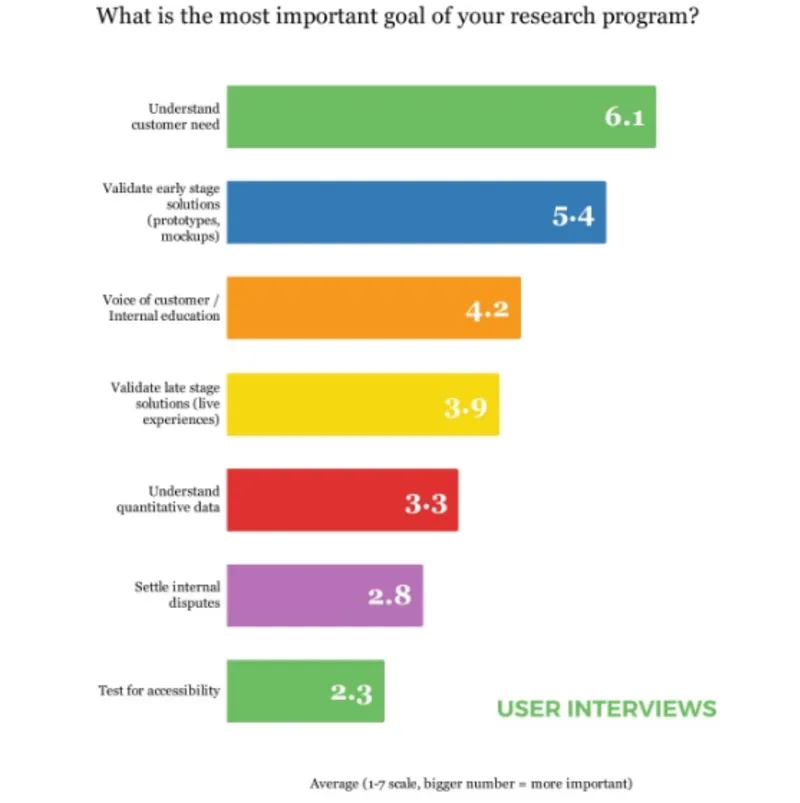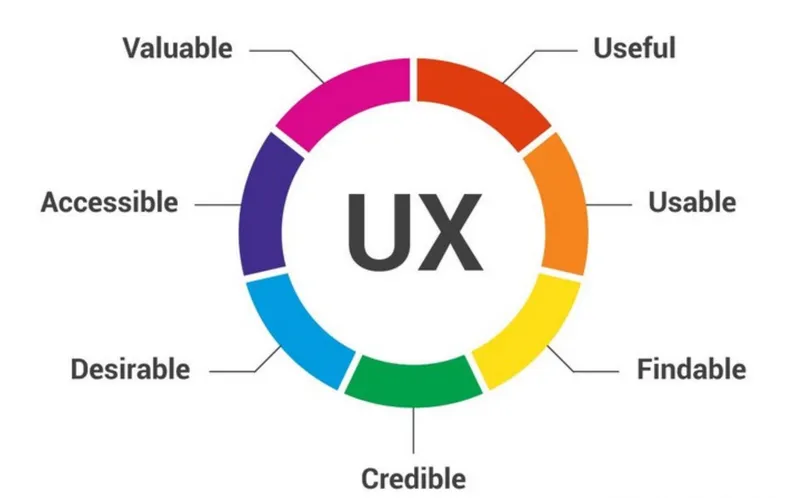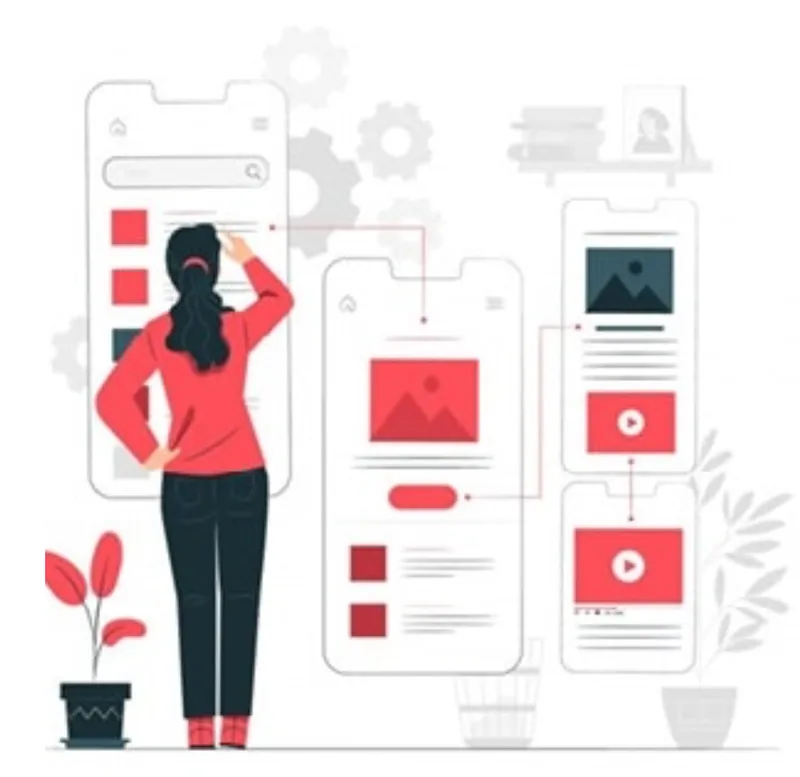

UX Research- Why Is It Necessary?
The imperative need to build design is supplemented by research. If designers are merely building solutions across the inputs from the client in the name of cost & sustainability, it will result is a run-of-the-mill product, a boxed product that was replicated or could be replicated.

The www.usainterviews.com conducted research on why companies and teams conducted research across various industries, job requirements and geographies. Their projections and analysis largely cover the underlying importance of research across different domains and the result is a product/solution that is well accepted on release. The core findings on a scale of 7, where 7 depicts the highest importance, states the value of research.

Source – www.usainetrviews.com
The projected results show the maximum research result is the engagement with customers to understand the customer need, followed by validating the prototypes to build better products or solutions.

Image Source – www.blogs.abode.com
Laura Kein, the author of UX Lean Start-ups & Build Better Products states:
"The only source of competitive advantage is the one that can survive technology fuelled disruption — an obsession with understanding, delighting, connecting with, and serving customers. In this age, companies that thrive are those that tilt their budgets toward customer knowledge and relationships."
Research is a fundamental step in the designing process. Rather the initial one, that builds the very foundation of design.
The imperative need to build design is supplemented by research. If designers are merely building solutions across the inputs from the client in the name of cost & sustainability, it will result is a run-of-the-mill product, a boxed product that was replicated or could be replicated. The core of UX design is research. If research is not substantially done, the result will be a blotched-up process ahead as well as hike in maintenance cost for salvaging the project.
Fundamentals of UX design

Image source – www.interaction-design.org
UX design is built around the fundamentals of the wheel above. The different parameters in varied proportions make for a successful product. But then, how does one arrive at a unique solution is by engaging in research around these parameters. Trends don't make a design acceptable, but its usability and usability is defined by the consumers.
Your Strategy for Research

Image source – www.freepik.com
Designers have been toying with different research instruments to derive qualitative as well as quantitative results. The time and cost factor are often the reasons that clients want to eliminate these two processes totally.
The designers are then left lurking with the challenge of designing by replicating existing designs or a sub-standard solution that will not come to benefit the end-user. The end-user is not the designer or the client. The end-user needs are different and varied and need to be decoded to a satisfying solution.
An end-user can effectively substantiate the gap between the client's demand and the designer's creative reach by providing real type data.
Broadly classified research is done in two formats
- Generative: Research on a set of consumers and a specific problem area.
- Evaluative: Research that is done on a design or a concept.
Research methodologies for the UX design can be classified as:
Lean UX:
Lean UX Research works on hypothesis, where a prototype is built and then user research is done around the prototype. This is a cost-saving measure.
Guerrilla Research:
Guerrilla Research is a random research methodology used in UX design research. The research entails a small chunk of users and evaluates certain design elements. Because of its narrow approach, it can be a cost-saving practise, but not holistically rewarding.
Heuristic Evaluation:
Heuristic Research and evaluation make use of the best practices and guidelines to arrive at analysis or decisions. This method can be used to eliminate future project lags and loopholes.
Building Hypothetical Personas:
Creating hypothetical personas of your consumer on the basis of the data presented by the client. In situations where user research is not possible due to time or money constraints, hypothetical personas can be built on assumptions.
Brainstorming:
Brainstorming is again based on data that is available from the research or an off-hand data that the client has presented. Brainstorming is again within the team and might fail to bring the consumer's perspective to the design.
Minimum Viable Research:
Minimum viable research is conducting research as much that it supplements the purpose of the project requirement. This means a cost-efficient measure
Subject Matter Expert Interviews:
This methodology makes use of subject matter expert advice and works around the directives shared by the expert. The expert works on the problem areas and offers analysis and solutions. This practice can bring a deeper level understanding of the topic of research, yet a little shy of the consumer experience.
UX research eliminates assumption, offers real-time data, brings a realistic outlook to prototyping, avoids design duplication or standardisation, offers scope to explore designs.
Skipping research will show its repercussions in the formative stages, when the possibility of change means more time and money investment, delay in schedules and at the end of it the distress when the consumer does not accept the solution as they cannot relate.

Image Source – Sherif Amin
Research is full filling experience because they result in:
- User-centric designs
- Target – user-specific solutions
- Target product usability and efficiency
- Understand customer pain points
- Helps build better workflow assessment and design prototype
- Eliminates future errors in the project
- Eliminates possible spiked-up project costs
- Successful goal achievement
- Well-accepted and efficient designs
- Lesser customer support calls
- Enhanced revenues
- Accelerated development at no extra cost
Quantifying on the Return on Investment
Often every client focuses on the return on investment, and as a designer to be able to convince a client that good research will certainly quantify to a good return on investment. Because then, you are making a bespoke product that purely answers the consumer queries and refines their experience.
The designer should involve all the stakeholders in the project and make them well aware of the value of research and future payoffs. The designer should be able to bring forth the project projection that not only is conveying of the technicalities, but the need for research to create an authentic and unique product.
As stated by www.usertesting.com, 'In a recent UserTesting study, 36% of companies reported that their UX budget had increased since last year, and 27% said that the increase was due to a change in attitude towards user research.'
It is an undeniable truth that UX research is not optional, but an important process that builds up to unique experiences.





